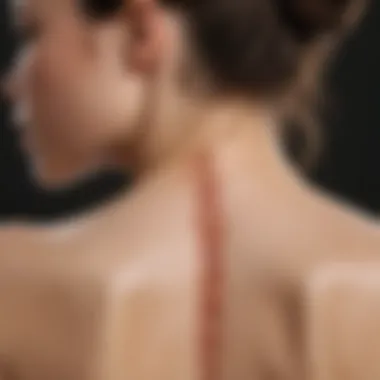A Comprehensive Guide to Back Acne Management


Intro
Back acne, often dismissed as a mere inconvenience, can deeply affect one’s quality of life. The term ‘bacne’ may sound trivial, but for many, it carries a weight of emotional distress and physical discomfort. Understanding the roots of this skin condition is crucial for effective management. This article serves as an in-depth guide to comprehensively addressing back acne, revealing its causes, preventive measures, and treatment options.
The discussion will cover both internal and external factors contributing to back acne. Armed with knowledge and strategies, readers can take proactive steps toward clearer skin. While many focus heavily on facial acne treatments, back acne often garners less attention, which can unintentionally perpetuate the cycle of frustration for those afflicted.
Adaptations in lifestyle, skincare, and even wardrobe choices can play significant roles in preventing and managing back acne. This guide aims to empower readers by providing a holistic view of the condition and emphasizing the importance of personalized skincare routines. Mastering these aspects not only helps to diminish back acne but also boosts overall self-esteem and comfort.
Understanding Back Acne
Understanding back acne is critical as it sets the foundation for addressing this skin condition. Back acne, often called bacne, is a type of acne that occurs on the back and shoulders. It can manifest in various forms, including pimples, cysts, and even nodules. Its presence is not just a cosmetic concern; it can significantly impact one’s self-esteem and comfort, particularly in social settings or during warm weather when revealing clothing is common.
This section will delve into what defines back acne and explore its underlying causes. By grasping the fundamental aspects of back acne, readers can better appreciate the importance of effective prevention strategies and treatments. Knowledge empowers individuals to take proactive measures rather than react to the issue only once it becomes noticeable.
What is Back Acne?
Back acne is similar to facial acne in composition and behavior but occurs in a different area of the body. Primarily, it results from clogged pores, which can occur due to an excess of oil production, dead skin cells, and bacteria. Factors like sweating, particularly during physical activity or hot weather, can aggravate this type of acne. Furthermore, back acne can range in severity; mild cases may consist of a few small pimples, while severe instances can involve painful cysts and widespread inflammation.
The reality of back acne is that it is not only a physical ailment but also a psychological one. People who experience it often feel embarrassed or self-conscious, leading to discomfort in social situations. Understanding its definition helps to normalize the condition and encourages individuals to seek ways to manage or treat it effectively.
The Anatomy of Acne
To comprehend back acne, it is essential to understand the basic anatomy of acne itself. The skin consists of glands that produce oil, known as sebaceous glands. When these glands overproduce oil, it can mix with dead skin cells and clog hair follicles.
Here are key components that contribute to acne formation:
- Hyperkeratosis: This refers to the excessive buildup of dead skin cells on the surface. When excess skin cells fail to shed appropriately, they create blockages in the pores.
- Oil Production: Overactive sebaceous glands can lead to increased oiliness. This is often influenced by hormonal fluctuations, particularly during puberty or menstrual cycles.
- Bacteria: A bacteria called Propionibacterium acnes can thrive in clogged hair follicles, leading to inflammation and the formation of pustules.
- Inflammation: The body’s immune response to the proliferation of bacteria can cause inflammation, resulting in the redness and swelling commonly associated with acne.
"Understanding these mechanisms is crucial in recognizing that acne is a multifactorial condition affected by both internal and external factors."
By grasping the anatomy of acne, individuals can make informed decisions regarding skincare and treatment options, directly supporting the journey towards clearer skin.
Causes of Back Acne
Understanding the causes of back acne is essential for anyone dealing with this condition. By identifying the specific factors contributing to back acne, one can adopt targeted strategies for prevention and treatment. This section discusses hormonal factors, lifestyle contributors, and dietary influences that play a significant role in the formation of back acne.
Hormonal Factors
Hormonal variations are a primary trigger for back acne. The body experiences hormonal fluctuations during puberty, menstrual cycles, pregnancy, and the use of certain medications. These changes can stimulate sebaceous glands, leading to excess oil production. When combined with dead skin cells and bacteria, this scenario creates an ideal environment for acne development.
Women, in particular, may notice increased breakouts during certain times of the month due to hormonal shifts related to their menstrual cycle. Understanding this connection can aid in anticipating breakouts and implementing preventive measures. For instance, practicing a consistent skincare routine during hormonal peaks can mitigate the effects of these changes.
Lifestyle Contributors
Various lifestyle choices significantly influence back acne. Factors such as stress, lack of sleep, and poor hygiene practices can exacerbate skin conditions. Stress triggers the release of cortisol, a hormone that can increase oil production. In turn, this excess oil clogs pores and can lead to acne flare-ups.
Moreover, inadequate sleep can impair skin regeneration, making it more susceptible to acne. Therefore, maintaining a regular sleep schedule not only benefits overall health but can also improve skin conditions. Lastly, poor hygiene is a notable contributor. Regularly washing the back, especially after workouts, can help reduce sweat, oils, and bacteria that can lead to breakouts.
Dietary Influences
Lastly, dietary habits can play a crucial role in back acne. Food choices can affect others aspects of health, including skin condition. Diets high in sugar and refined carbohydrates may lead to insulin spikes, which in turn can promote inflammation and acne. Conversely, diets rich in fruits, vegetables, and whole grains may support skin health by providing essential nutrients such as vitamins A, C, and E.
In summary, understanding the causes of back acne is vital for effective management. Hormonal fluctuations, lifestyle choices, and dietary influences all contribute to this condition. By recognizing these factors, targeted strategies can be implemented for prevention and treatment.
"Addressing the root causes of back acne can lead to more effective and lasting solutions."
Preventive Measures


Preventive measures are crucial in managing back acne effectively. Maintaining a consistent and tailored approach can help reduce the likelihood of breakouts. This section discusses different strategies that can play a significant role in preventing back acne, including skincare routines, clothing choices, and hygiene practices.
Skincare Routine
A well-crafted skincare routine is essential for preventing back acne. This includes several components, such as selecting the right cleanser, proper exfoliation, and suitable moisturizing practices for acne-prone skin.
Choosing the Right Cleanser
Choosing the right cleanser is key to managing back acne. It should ideally contain ingredients like salicylic acid or benzoyl peroxide, known for their acne-fighting properties. A good cleanser helps to remove excess oil and dirt from the skin, which can contribute to breakouts.
The main characteristic of an effective cleanser is its formulation. A gel or foaming cleanser often works well for oily skin types, while cream-based cleansers may suit those with sensitive or dry skin. The unique feature of choosing the right cleanser is that it can prevent pore-clogging, which is critical in avoiding blemishes. However, too harsh a product may cause irritation, which can worsen skin conditions.
Exfoliation Techniques
Exfoliation techniques are important to consider in your skincare routine. Regular exfoliation helps to remove dead skin cells, which can clog pores and promote acne formation. Chemical exfoliants, like alpha-hydroxy acids (AHAs) and beta-hydroxy acids (BHAs), are popular for their effectiveness.
The key characteristic of suitable exfoliation is its gentleness. Over-exfoliation can lead to skin irritation and further issues. Finding balance is vital; once or twice a week is often beneficial. The unique feature of maintaining a consistent exfoliation routine is the promotion of skin renewal. However, improper techniques or frequency can result in increased sensitivity or redness.
Moisturizing for Acne-Prone Skin
Moisturizing for acne-prone skin cannot be overlooked. Even oily skin needs adequate hydration to maintain balance. Many believe that oily skin does not require moisturizing, but this is a misconception. Non-comedogenic moisturizers, which do not clog pores, are the best choice. They provide necessary hydration without exacerbating acne conditions.
The main characteristic of effective moisturizers is their lightweight formulation. Products that contain ingredients like hyaluronic acid or glycerin offer hydration without being heavy or greasy. The unique feature of using suitable moisturizers is their ability to protect the skin barrier. Nonetheless, using heavy or oil-based moisturizers can lead to further breakouts.
Clothing Choices
Clothing plays a significant role in preventing back acne. The choices made regarding fabric and fit can influence the development of blemishes.
Fabric Selections
Selecting the right fabrics for clothing is essential. Natural fibers like cotton allow the skin to breathe, reducing moisture and heat buildup on the skin. This is particularly important during warm weather or when engaging in physical activities.
The key characteristic of effective fabric selections is breathability. Fabrics that wick moisture away are beneficial as they help to keep the skin dry. The unique feature of choosing breathable fabrics is the reduction of humidity on the skin, effectively minimizing the risk of breakouts. However, synthetic materials that trap heat can exacerbate the problem, leading to further skin issues.
Fit Considerations
Fit considerations are equally important in clothing choices. Wearing tight-fitting clothes can lead to irritation and friction against the skin, which can contribute to breakouts.
The main characteristic of appropriate fit is comfort. Loose-fitting clothing allows for air circulation and reduces skin irritation. The unique aspect of considering fit is the prevention of mechanical irritation, which can aggravate existing acne. Still, extremely loose clothing may not offer the support needed during physical activities, so a balance must be struck.
Importance of Hygiene
Maintaining good hygiene is fundamental in preventing back acne. This includes adopting proper shower techniques and practicing effective laundry habits.
Shower Techniques
Shower techniques matter significantly. After sweating or engaging in physical activity, it is important to shower as soon as possible. This aids in washing off sweat, oil, and dirt that can clog pores.
The key characteristic of effective shower techniques involves using lukewarm water. Hot water may dry out the skin, prompting it to produce more oil. The unique feature of practicing effective shower routines is the dual effect of cleansing and soothing the skin. Yet, using aggressive scrubbing tools can irritate the skin, leading to more acne.
Laundry Practices
Laundry practices are an often neglected aspect of preventing back acne. Regularly washing bed linens, towels, and clothing is vital, especially for those with acne-prone skin. Bacteria, oils, and dirt build up on fabrics, potentially leading to breakouts.
The main feature of effective laundry practices includes using gentle detergents free from harsh chemicals. This helps reduce the chances of skin reactions. The unique aspect of maintaining clean fabrics is reducing the risk of transferring bacteria back to the skin. However, excessive laundry frequency can be inconvenient and increase water usage, which is a consideration for many.
Treatment Options
Dealing with back acne can be frustrating and challenging. Understanding the different treatment options available is crucial in finding the right approach for your skin. Various treatments can significantly impact acne severity and overall skin health. This section addresses topical treatments and oral medications. Each treatment has its unique benefits and considerations, making it important to choose wisely.


Topical Treatments
Topical treatments are often the first line of defense in combating back acne. They directly address the skin's surface and can target specific issues such as excess oil and clogged pores. Here are some effective topical treatments:
Benzoyl Peroxide
Benzoyl peroxide is a widely recognized ingredient in acne treatment. Its primary function is to reduce the presence of bacteria that can lead to inflammation and breakouts. One of the key characteristics of benzoyl peroxide is its ability to penetrate deep into the skin, allowing it to unclog pores effectively.
Its unique feature lies in its antimicrobial properties, which help in decreasing acne. It's a beneficial choice because it not only prevents new lesions but also promotes healing of existing ones. However, it can cause dryness or irritation for some individuals, so it's essential to start with a lower concentration and gradually increase usage as tolerated.
Salicylic Acid
Salicylic acid is another popular option for treating back acne. Known for its exfoliating properties, it aids in removing dead skin cells that contribute to clogged pores. Its key characteristic is its ability to penetrate oily skin, targeting the root causes of acne.
This makes salicylic acid a beneficial choice for those with oily back skin. It helps reduce the inflammation associated with acne and can prevent future outbreaks. However, some may find it too drying, so proper follow-up hydration is necessary to maintain skin moisture.
Retinoids
Retinoids represent a powerful group of topical treatments that promote skin cell turnover. They work by stimulating collagen production and preventing pores from becoming blocked. The key characteristic of retinoids is their effectiveness in treating both existing acne and preventing future breakouts.
Using retinoids can significantly improve skin texture and tone. However, they may cause irritation, especially at the start of treatment, necessitating a slow introduction to the regimen. Users should also avoid excessive sun exposure while using retinoids, as their efficacy may decrease with UV exposure.
Oral Medications
In more severe cases of back acne, oral medications may become necessary. These drugs often work from the inside out, addressing systemic issues that contribute to acne. Here are two types of oral medications:
Antibiotics
Antibiotics like tetracyclines are effective in managing acne by reducing bacteria on the skin and decreasing inflammation. Their key characteristic is their ability to target the bacteria responsible for acne without affecting skin cells negatively.
Antibiotics can be a beneficial option for individuals with moderate to severe back acne. They often provide quick results by reducing the population of acne-causing bacteria. However, they can lead to potential side effects, such as digestive disturbances or increased sensitivity to sunlight, making it essential to follow a healthcare provider's advice closely.
Hormonal Therapy
Hormonal therapy is another approach, particularly for women experiencing acne related to hormonal changes. It involves using medications that regulate hormones contributing to acne development.
The key characteristic of hormonal therapy is its ability to address the underlying hormonal imbalance rather than just the symptoms. It is a beneficial choice for those whose acne worsens around menstrual cycles. Nevertheless, hormonal treatments may take time to show effects and have possible side effects, requiring careful management under a physician's guidance.
Overall, understanding and selecting the right treatment options is crucial for managing back acne effectively. Each choice provides unique advantages and disadvantages, emphasizing the need for personalized approaches based on individual skin types and conditions.
When to Seek Professional Help
Dealing with back acne can be a challenging journey. While many cases can be managed with home treatments and lifestyle changes, certain situations may warrant professional intervention. Recognizing when to seek expert help is crucial in preventing a condition that can worsen or lead to lasting skin issues.
Identifying Severe Cases
Not all acne on the back is equal. When considering seeking professional help, it is important to identify severe cases. Symptoms that indicate the need for expert care include:
- Persistent Acne: If back acne continues despite consistent home treatment, it might be time to consult a professional.
- Painful Lesions: Discomfort or pain associated with acne may signify a more serious underlying issue.
- Scarring or Dark Marks: Any signs of scarring or hyperpigmentation could require specialized treatment.
- Spread of Acne: If acne spreads to other areas of the body, it's advisable to seek professional help.
If you experience these indicators, it is worth examining the reasons that might necessitate a consultation.
Types of Professionals to Consult
When considering assistance for back acne, two main professionals can provide valuable insights: dermatologists and estheticians. Each plays a distinct role in addressing skin health and can help manage the condition effectively.
Dermatologists


Dermatologists are medical doctors specializing in skin conditions. Their expertise is significant for individuals dealing with severe back acne.
- Key Characteristic: They have extensive training in diagnosing and treating various skin issues.
- Benefits: Their ability to prescribe medications, including topical and oral treatments, sets them apart. Dermatologists can tailor treatment plans that suit individual needs. They understand the complex nature of the skin and can address underlying causes, like hormonal changes or infection, which may contribute to severe breakouts.
- Unique Feature: Dermatologists can perform procedures such as chemical peels or laser therapy, which might be necessary for treating acne scars or persistent outbreaks. While they offer a more medical approach, their services may be more expensive than those of estheticians, and some treatments may not be covered by insurance, depending on the policy.
Estheticians
Estheticians focus on skin care and can provide strategies for managing back acne through non-medical means.
- Key Characteristic: They specialize in cosmetic skin treatments, emphasizing cleansing and exfoliation. Their knowledge about skincare products can help individuals make better choices.
- Benefits: Estheticians often provide personalized skincare routines that can aid in the prevention of breakouts. They can educate the individual on proper product use and suggest suitable treatments suited to different skin types. They also perform practical treatments , such as facials or extractions, to promote clearer skin. However, it’s important to acknowledge their limitations; estheticians cannot prescribe medications or diagnose serious medical conditions.
Seeking professional help can drastically change the journey of managing back acne. Understanding when to reach out and knowing the right professional can lead to effective treatment and improved skin health.
Professional consultation is essential for identifying severe cases of acne and utilizing specialized treatments to achieve clearer skin.
By remaining aware of the signs and options available, individuals can ensure they are taking the right steps towards effective management.
Long-term Management Strategies
Long-term management strategies are crucial in dealing with back acne. While short-term treatments can provide immediate relief, addressing the underlying issues is imperative for sustainable results. This section details strategies that help maintain skin clarity, reduce the frequency of breakouts, and enhance overall skin health.
Regular Monitoring
Regular monitoring of back acne can play a pivotal role in identifying the patterns and triggers that lead to breakouts. Keeping a skincare diary can help track product effectiveness and skin changes over time. It aids in recognizing what works and what doesn't. Noting flare-ups in relation to dietary habits, hormonal cycles, and stress levels can provide insight into causative factors.
Adapting Lifestyle Changes
Making lifestyle adjustments is an essential part of long-term management. These changes not only address immediate concerns but also promote overall well-being.
Stress Management
Stress management is a key factor in the long-term control of back acne. Stress can trigger hormonal changes that contribute to acne development. By incorporating strategies such as mindfulness, meditation, or yoga, individuals can reduce their stress levels. This approach is a beneficial choice, as it not only helps manage acne but also improves mental wellness.
The unique feature of stress management is its holistic nature. It provides physical and mental benefits, making it an effective strategy for many individuals. However, it's important to find methods that resonate personally, as effectiveness can vary from one person to another.
Exercise Routines
Exercise routines contribute significantly to the management of back acne. Physical activity increases blood circulation and helps in detoxifying the body. It promotes healthy skin by delivering essential nutrients and oxygen. Moreover, regular exercise is beneficial for overall health, which can influence skin conditions positively.
The key characteristic of exercise is its versatility. Activities can range from brisk walking to high-intensity workouts, making it accessible for nearly everyone. However, it is critical to choose appropriate clothing and shower promptly after exercising to prevent sweat and bacteria buildup on the skin.
Finale
In the journey to address back acne, recapping the major takeaways from this article is essential. Understanding back acne allows individuals to grasp its potential impact on their lives. It is not just a cosmetic issue; rather, it can lead to emotional distress and affect self-esteem significantly. Recognizing the causes behind this skin condition empowers readers to make informed choices for prevention and treatment.
- Key Takeaways: Prevention strategies, treatment options, and when to seek professional help are critical components in managing back acne effectively.
- Lifestyle Adjustments: Simple changes in lifestyle can lead to significant improvements in skin condition. Adding exercise and managing stress levels can contribute positively to one's skin health.
Recap of Key Points
The information gathered throughout this article covers diverse aspects of back acne. The fundamental points include:
- Understanding Back Acne: Acknowledging what back acne is and how it forms is the starting point in addressing this issue.
- Identifying Causes: Hormonal changes, lifestyle decisions, and dietary choices play pivotal roles in the development of back acne.
- Prevention: Implementing a dedicated skincare routine, choosing appropriate clothing, and maintaining good hygiene can significantly reduce breakouts.
- Treatment Options: There are both topical and oral treatments available, catering to various levels of severity in acne.
- Professional Guidance: Knowing when to consult with a dermatologist or esthetician can provide additional support and treatment avenues.
- Long-term Management: Developing strategies for long-term monitoring and adapting lifestyle changes help maintain clearer skin.
Empowerment through Knowledge
Knowledge is a powerful tool in the fight against back acne. Gaining insight into the factors that contribute to this condition not only enhances self-understanding but also fosters the ability to make proactive choices regarding one’s skin health.
- Understanding the complexities of acne leads to better emotional and mental health.
- Knowledge equips individuals with the means to navigate skincare options effectively.
Additionally, staying informed about the latest treatments and preventive measures enables individuals to adjust their routines as new information or products arise in the skincare industry.
By embracing this empowerment, readers can take control of their back acne journey, ultimately leading to improved confidence and comfort in their own skin. Therefore, it is vital to prioritize education on this topic for those who seek to manage their acne effectively.
"Empowerment comes from understanding your skin and taking informed actions toward its health."
Thus, concluding with a clear awareness of back acne provides a strong foundation for readers. It encourages them to take charge of their skin health and fosters an empowered approach to pursuing clearer and healthier skin.



